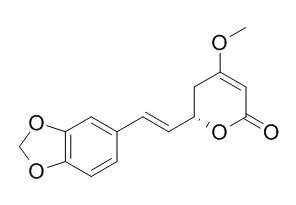| Kinase Assay: |
| Toxicol Sci. 2011 Dec;124(2):388-99. | | Methysticin and 7,8-dihydromethysticin are two major kavalactones in kava extract to induce CYP1A1.[Pubmed: 21908763] | Kava is a plant traditionally used for making beverages in Pacific Basin countries and has been used for the treatment of nervous disorders in the United States. The pharmacological activity of kava is achieved through kavalactones in kava extract, which include kawain, 7,8-dihydrokawain, yangonin, 5,6-dehydrokawain, Methysticin, and 7,8-dihydroMethysticin.
METHODS AND RESULTS:
Recent studies have shown that kava extract induces hepatic CYP1A1 enzyme; however, the mechanisms of CYP1A1 induction have not been elucidated, and the kavalactones responsible for CYP1A1 induction have not yet been identified. Using a combination of biochemical assays and molecular docking tools, we determined the functions of kava extract and kavalactones and delineated the underlying mechanisms involved in CYP1A1 induction. The results showed that kava extract displayed a concentration-dependent effect on CYP1A1 induction. Among the six major kavalactones, Methysticin triggered the most profound inducing effect on CYP1A1 followed by 7,8-dihydroMethysticin. The other four kavalactones (yangonin, 5,6-dehydrokawain, kawain, and 7,8-dihydrokawain) did not show significant effects on CYP1A1. Consistent with the experimental results, in silico molecular docking studies based on the aryl hydrocarbon receptor (AhR)-ligand binding domain homology model also revealed favorable binding to AhR for Methysticin and 7,8-dihydroMethysticin compared with the remaining kavalactones. Additionally, results from a luciferase gene reporter assay suggested that kava extract, Methysticin, and 7,8-dihydroMethysticin were able to activate the AhR signaling pathway. Moreover, kava extract-, Methysticin-, and 7,8-dihydroMethysticin-mediated CYP1A1 induction was blocked by an AhR antagonist and abolished in AhR-deficient cells.
CONCLUSIONS:
These findings suggest that kava extract induces the expression of CYP1A1 via an AhR-dependent mechanism and that Methysticin and 7,8-dihydroMethysticin contribute to CYP1A1 induction. The induction of CYP1A1 indicates a potential interaction between kava or kavalactones and CYP1A1-mediated chemical carcinogenesis. | | Bioorg Med Chem Lett. 2009 Oct 1;19(19):5732-6. | | Identification of methysticin as a potent and non-toxic NF-kappaB inhibitor from kava, potentially responsible for kava's chemopreventive activity.[Pubmed: 19716299] | Nuclear factor-kappaB (NF-kappaB) is a transcription factor that plays an essential role in cancer development.
METHODS AND RESULTS:
The results of our recent chemopreventive study demonstrate that kava, a beverage in the South Pacific Islands, suppresses NF-kappaB activation in lung adenoma tissues, potentially a mechanism responsible for kava's chemopreventive activity.
CONCLUSIONS:
Methysticin is identified as a potent NF-kappaB inhibitor in kava with minimum toxicity. Other kava constituents, including four kavalactones of similar structures to Methysticin, demonstrate minimum activities in inhibiting NF-kappaB. |
|






 Cell. 2018 Jan 11;172(1-2):249-261.e12. doi: 10.1016/j.cell.2017.12.019.IF=36.216(2019)
Cell. 2018 Jan 11;172(1-2):249-261.e12. doi: 10.1016/j.cell.2017.12.019.IF=36.216(2019) Cell Metab. 2020 Mar 3;31(3):534-548.e5. doi: 10.1016/j.cmet.2020.01.002.IF=22.415(2019)
Cell Metab. 2020 Mar 3;31(3):534-548.e5. doi: 10.1016/j.cmet.2020.01.002.IF=22.415(2019) Mol Cell. 2017 Nov 16;68(4):673-685.e6. doi: 10.1016/j.molcel.2017.10.022.IF=14.548(2019)
Mol Cell. 2017 Nov 16;68(4):673-685.e6. doi: 10.1016/j.molcel.2017.10.022.IF=14.548(2019)